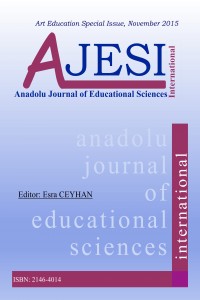Pictures And Words: Celebrating Plurality Through Collaborative Storytelling With Traditional Artists Of Rajasthan, India
Öz
In Rajasthan, the western region of India, we find a folk tradition of storytelling that is unique for its verbal and visual quality that celebrates plurality. The Kaavad is a painted wooden shrine, used by the itinerant storyteller to recite stories and genealogies for his hereditary patrons. The multi-paneled box is covered with images that are identified by the storyteller as he unfolds the box. He uses the same image to recite multiple narratives and to identify patrons from various villages. Contrary to other practices where the image particularizes the word, here the word or voice particularizes the image. This makes the Kaavad highly inclusive because it allows an image to hold many stories and several persons to be a part of a narrative or shrine.
Inspired and informed by our doctoral research around the Kaavad phenomenon, several media artefacts were created exploring the implicit relationship between words and images. We collaborated with the Kaavad makers and the storytellers to make animated films and illustrated books. In the illustrated book ‘Home’, we explored the idea of using images as ‘prompts’ for children to construct their own multiple narratives and to express their worldview around the themes of home and identity. The animated film Baat Wahi Hai (It’s the same story) made with traditional artists and storytellers suggests that there are mulitple ways in which ideas may be shared.
In this paper we present our experiments with collaborative storytelling with traditional artists to create an awareness of cultural diversity and to celebrate plurality through words and images.
Anahtar Kelimeler
Kaynakça
- Achuthan, K. (2011). One world, many windows: Children’s responses to a postmodern picturebook. (Unpublished Mphil paper). University of Cambridge. UK. Asha for Education (n.d.) Retrieved from http://www.ashanet.org/index.php?page=about
- Bakhtin, M. M. (2004). The Dialogic Imagination: Four Essays. (C. Emerson & M. Holquist, Trans.). Austin: University of Texas Press.
- Dehejia, V. (1990). On odes of visual narration in early Budhhist art. The art bulletin 72 (3), 374-392.
- Jain, J. (1998). Picture showmen. Mumbai: Marg Publications.
- Lévi-Strauss, C. (1968) Structural anthropology. (C. Jacobson, & B. G. Schoepnf, Trans.) Penguin Books.
- Lyons, T. (2007). Mewari perspectives: Udaipur, Nathdwara, Basi. In J. Williams. (Ed.) Kingdom of the sun: Indian court and village art from the princely state of Mewar, 35-51. San Francisco: Asian Art Museum.
- Mair, V. H. Painting and performance: Chinese picture recitation and its Indian genesis. Honolulu: University of Hawaii Press, 1988.
- Mitchell, W.J.T (1984, Spring). What is an image? New Literary Society 15(3), 503-537. The Johns Hopkins University Press.
- Nodelman, P. (1988). Words about pictures: The narrative art of children’s picture books, The University of Georgia Press.
- Sabnani, N. (2012, Autumn). Prompting narratives: The Kaavad phenomenon. IIC Quarterly, 39 (2), 11-19. New Delhi: India International Centre
- Sabnani, N. (In press 2014). Kaavad tradition of Rajasthan: A portable pilgrimage. New Delhi: Niyogi Books.
- Schapiro, M. (1996). Words, script and pictures: Semiotics of visual language. NY: George Braziller.
- Singh, K. (1995). The pictures of showmen: Structure and function of images in the picture showmen tradition. Chandigarh: Department of Fine Arts, Panjab University.
- Turner, V. (1979). Process, performance and pilgrimage. New Delhi: Concept Publishing Company.
- Turner, V. (1969). The ritual process: Structure and anti-structure. NY: Aldine De Gruyer.
- Varga, K. A. (1989). Criteria for describing word-image relationship. Poetics Today, 10 (1), 31-53. Duke University Press.
Öz
Kaynakça
- Achuthan, K. (2011). One world, many windows: Children’s responses to a postmodern picturebook. (Unpublished Mphil paper). University of Cambridge. UK. Asha for Education (n.d.) Retrieved from http://www.ashanet.org/index.php?page=about
- Bakhtin, M. M. (2004). The Dialogic Imagination: Four Essays. (C. Emerson & M. Holquist, Trans.). Austin: University of Texas Press.
- Dehejia, V. (1990). On odes of visual narration in early Budhhist art. The art bulletin 72 (3), 374-392.
- Jain, J. (1998). Picture showmen. Mumbai: Marg Publications.
- Lévi-Strauss, C. (1968) Structural anthropology. (C. Jacobson, & B. G. Schoepnf, Trans.) Penguin Books.
- Lyons, T. (2007). Mewari perspectives: Udaipur, Nathdwara, Basi. In J. Williams. (Ed.) Kingdom of the sun: Indian court and village art from the princely state of Mewar, 35-51. San Francisco: Asian Art Museum.
- Mair, V. H. Painting and performance: Chinese picture recitation and its Indian genesis. Honolulu: University of Hawaii Press, 1988.
- Mitchell, W.J.T (1984, Spring). What is an image? New Literary Society 15(3), 503-537. The Johns Hopkins University Press.
- Nodelman, P. (1988). Words about pictures: The narrative art of children’s picture books, The University of Georgia Press.
- Sabnani, N. (2012, Autumn). Prompting narratives: The Kaavad phenomenon. IIC Quarterly, 39 (2), 11-19. New Delhi: India International Centre
- Sabnani, N. (In press 2014). Kaavad tradition of Rajasthan: A portable pilgrimage. New Delhi: Niyogi Books.
- Schapiro, M. (1996). Words, script and pictures: Semiotics of visual language. NY: George Braziller.
- Singh, K. (1995). The pictures of showmen: Structure and function of images in the picture showmen tradition. Chandigarh: Department of Fine Arts, Panjab University.
- Turner, V. (1979). Process, performance and pilgrimage. New Delhi: Concept Publishing Company.
- Turner, V. (1969). The ritual process: Structure and anti-structure. NY: Aldine De Gruyer.
- Varga, K. A. (1989). Criteria for describing word-image relationship. Poetics Today, 10 (1), 31-53. Duke University Press.
Ayrıntılar
| Birincil Dil | İngilizce |
|---|---|
| Bölüm | Araştırma Makalesi |
| Yazarlar | |
| Yayımlanma Tarihi | 16 Aralık 2015 |
| Gönderilme Tarihi | 16 Aralık 2015 |
| Yayımlandığı Sayı | Yıl 2015 Cilt: 5 Sayı: 3 |
Kaynak Göster

AJESI’de yayınlanan makalelerde bu lisans kullanılmaktadır.
Creative Commons Attribution-NonCommercial-ShareAlike 4.0 International License.


